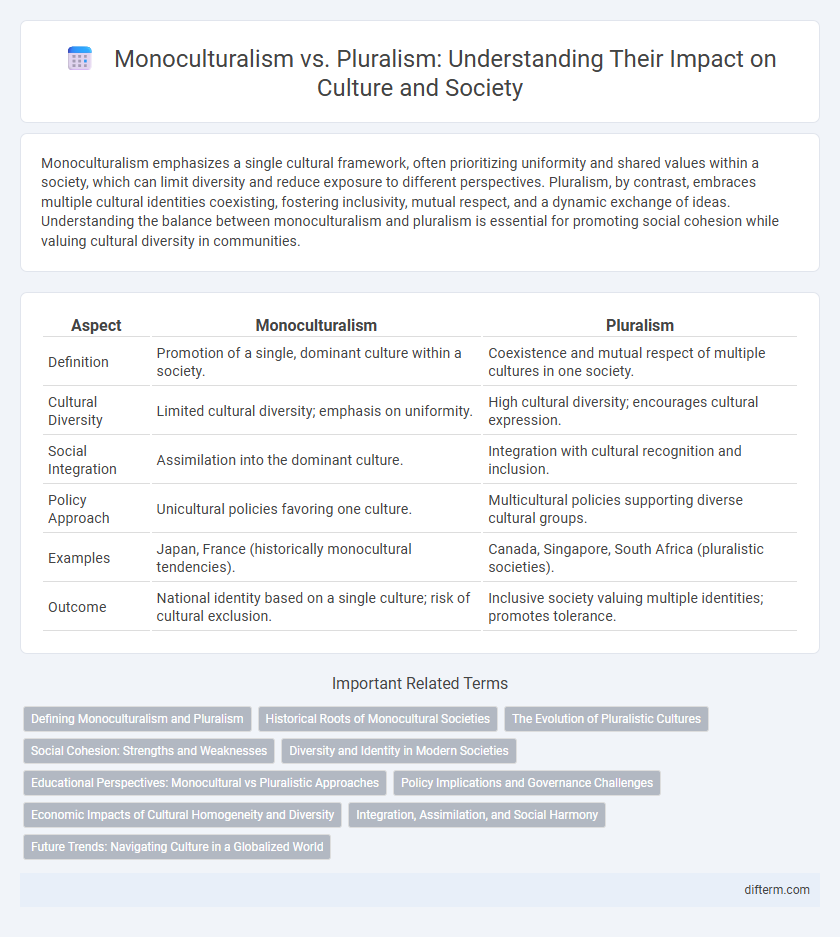Monoculturalism emphasizes a single cultural framework, often prioritizing uniformity and shared values within a society, which can limit diversity and reduce exposure to different perspectives. Pluralism, by contrast, embraces multiple cultural identities coexisting, fostering inclusivity, mutual respect, and a dynamic exchange of ideas. Understanding the balance between monoculturalism and pluralism is essential for promoting social cohesion while valuing cultural diversity in communities.
Table of Comparison
| Aspect | Monoculturalism | Pluralism |
|---|---|---|
| Definition | Promotion of a single, dominant culture within a society. | Coexistence and mutual respect of multiple cultures in one society. |
| Cultural Diversity | Limited cultural diversity; emphasis on uniformity. | High cultural diversity; encourages cultural expression. |
| Social Integration | Assimilation into the dominant culture. | Integration with cultural recognition and inclusion. |
| Policy Approach | Unicultural policies favoring one culture. | Multicultural policies supporting diverse cultural groups. |
| Examples | Japan, France (historically monocultural tendencies). | Canada, Singapore, South Africa (pluralistic societies). |
| Outcome | National identity based on a single culture; risk of cultural exclusion. | Inclusive society valuing multiple identities; promotes tolerance. |
Defining Monoculturalism and Pluralism
Monoculturalism centers on the dominance of a single cultural group within a society, often leading to uniformity in language, traditions, and social practices. Pluralism embraces multiple cultural groups coexisting, encouraging diversity, mutual respect, and the preservation of distinct cultural identities. Effective understanding of these concepts is vital for addressing social integration, cultural policy, and community development.
Historical Roots of Monocultural Societies
Monocultural societies often trace their historical roots to centralized political systems and geographic isolation, which fostered cultural homogeneity and limited external influences. Agricultural developments and shared linguistic traditions further reinforced a singular cultural identity within these communities. This monocultural foundation contrasts with pluralistic societies, where historical trade routes, conquests, and migration introduced diverse cultural elements and promoted multicultural coexistence.
The Evolution of Pluralistic Cultures
Pluralistic cultures have evolved through increased global interconnectedness, fostering diverse identities within shared societies and promoting inclusivity beyond monocultural norms. This evolution is marked by the recognition and celebration of multiple cultural narratives, enabling social cohesion amid diversity. The shift from monoculturalism to pluralism reflects a dynamic adaptation to migration, communication technologies, and cross-cultural exchanges shaping modern multicultural landscapes.
Social Cohesion: Strengths and Weaknesses
Monoculturalism promotes social cohesion by fostering a shared identity and common values, which can lead to strong group solidarity and reduced social conflicts. However, it may also result in exclusionary practices and marginalization of minority groups, limiting diversity and innovation. Pluralism encourages inclusion and respect for multiple cultural identities, enhancing social integration and cultural exchange, yet it can pose challenges to unity and create tensions if cultural differences are not effectively managed.
Diversity and Identity in Modern Societies
Monoculturalism emphasizes a single cultural identity, often leading to uniformity and potentially marginalizing minority groups, whereas pluralism embraces diversity by recognizing and celebrating multiple cultural identities within a society. Modern societies benefit from pluralism as it fosters inclusion, social cohesion, and innovation through the interaction of diverse perspectives and traditions. The dynamic balance between maintaining cultural identity and promoting diversity is crucial for sustainable social development and peaceful coexistence.
Educational Perspectives: Monocultural vs Pluralistic Approaches
Monocultural educational approaches prioritize a singular cultural framework, often emphasizing uniform values and traditions that align with the dominant culture, potentially limiting students' exposure to diverse perspectives. Pluralistic education embraces multiple cultural narratives, promoting inclusivity and critical thinking by integrating varied cultural histories, languages, and practices within the curriculum. Research indicates that pluralistic approaches enhance intercultural understanding, social cohesion, and prepare students for global citizenship more effectively than monocultural models.
Policy Implications and Governance Challenges
Monoculturalism in policy promotes social uniformity by enforcing a single dominant cultural norm, often leading to exclusion and marginalization of minority groups. In contrast, pluralism embraces cultural diversity through inclusive governance frameworks that recognize and accommodate multiple cultural identities, but this approach requires complex policymaking to balance competing interests and ensure equitable resource distribution. Governance challenges include managing cultural conflicts, preventing discrimination, and fostering social cohesion while upholding minority rights within both monocultural and pluralistic systems.
Economic Impacts of Cultural Homogeneity and Diversity
Monoculturalism often leads to economic stagnation due to limited innovation and reduced global market adaptability, as homogeneous cultures may lack diverse perspectives crucial for creative problem-solving. In contrast, cultural pluralism fuels economic growth by fostering diverse skill sets, encouraging cross-cultural collaboration, and stimulating innovation through varied consumer demands and entrepreneurial ventures. Studies reveal that economies embracing diversity typically experience higher productivity, increased foreign investment, and greater resilience against economic shocks.
Integration, Assimilation, and Social Harmony
Monoculturalism emphasizes assimilation, often requiring minority groups to adopt the dominant culture's norms and values, which can streamline social integration but risks eroding cultural diversity. Pluralism encourages integration by valuing multiple cultural identities and fostering social harmony through mutual respect and inclusion. Successful social harmony emerges when diverse groups maintain distinct identities while collaboratively engaging in shared societal goals.
Future Trends: Navigating Culture in a Globalized World
Monoculturalism faces increasing challenges as globalization intensifies cultural exchange and migration, promoting pluralism through diverse, interconnected societies. Future trends emphasize adaptive cultural policies that support multicultural coexistence, fostering innovation, social cohesion, and economic resilience. Digital communication platforms accelerate cultural interaction, enabling pluralistic perspectives to shape evolving global identities.
Monoculturalism vs Pluralism Infographic

 difterm.com
difterm.com